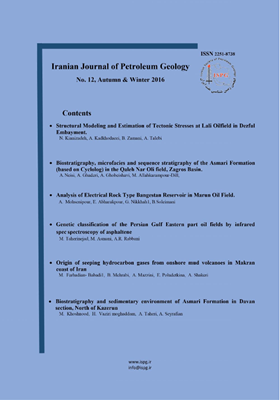Genetic classification of the Persian Gulf Eastern part oil fields by infrared spectroscopy of asphaltene samples
Subject Areas : GeochemistryMorteza Taherinezhad 1 , Morteza Asemani 2 , Ahmad reza Rabbani 3 *
1 -
2 -
3 -
Keywords: Asphaltene, Fourier transform infrared (FTIR) spectroscopy Oil-oil correlation Persian Gulf Iran,
Abstract :
Asphaltene is always considered as a problem in oil industry. But, asphaltenes are desirable compounds in geochemical studies specially in oil-oil correlation. Oil-oil correlation is one of the most important issues in geochemical studies that enables to classify oils genetically. Asphaltenes due to their structural similarity with kerogen and unaffected and/or little affected from secondary processes are known as valuable compounds in geochemical studies. So, in this paper the structural characteristics of asphaltenes were considered as a correlation parameter. For this study 5 oil samples were collected from the Persian Gulf eastern part oil fields. Structural characteristics of these asphaltenes were investigated by Fourier transform infrared (FTIR) spectroscopy. 2D and 3D graphs based on aliphatic and aromatic compounds (predominant compounds in asphaltenes structure) and sulfoxide and carbonyl functional groups (which are represent of sulfur and oxygen abundance in asphaltenes) were used for comparison of asphaltenes structure in different samples. According to the results of these defined graphs, the studied oil samples comprise two oil families with distinct genetic characteristics. The first oil family consists of the Salman and Reshadat oil samples, and the second oil family consists of the Resalat, Siri E and Siri D oil samples. To validation and complement the obtained results, the other common geochemical techniques such as stable carbon isotope and biomarkers parameters, were employed and these techniques completely confirmed previous results. According to biomarker parameters, the first oil family originated from marl source rock and the second oil family was sourced from carbonate source rock.

